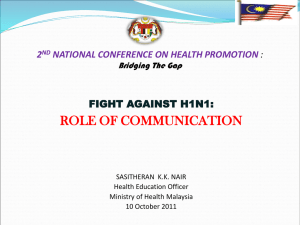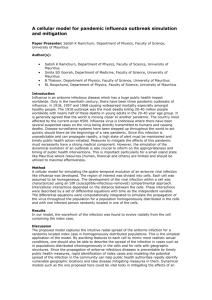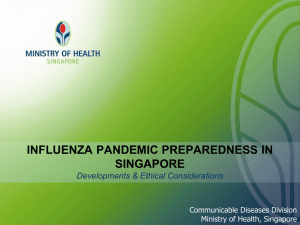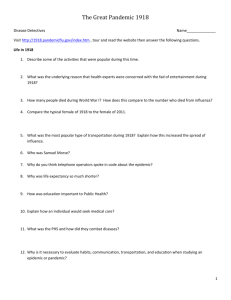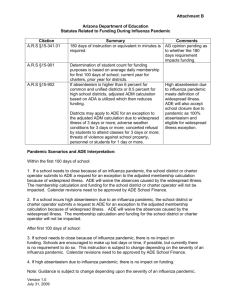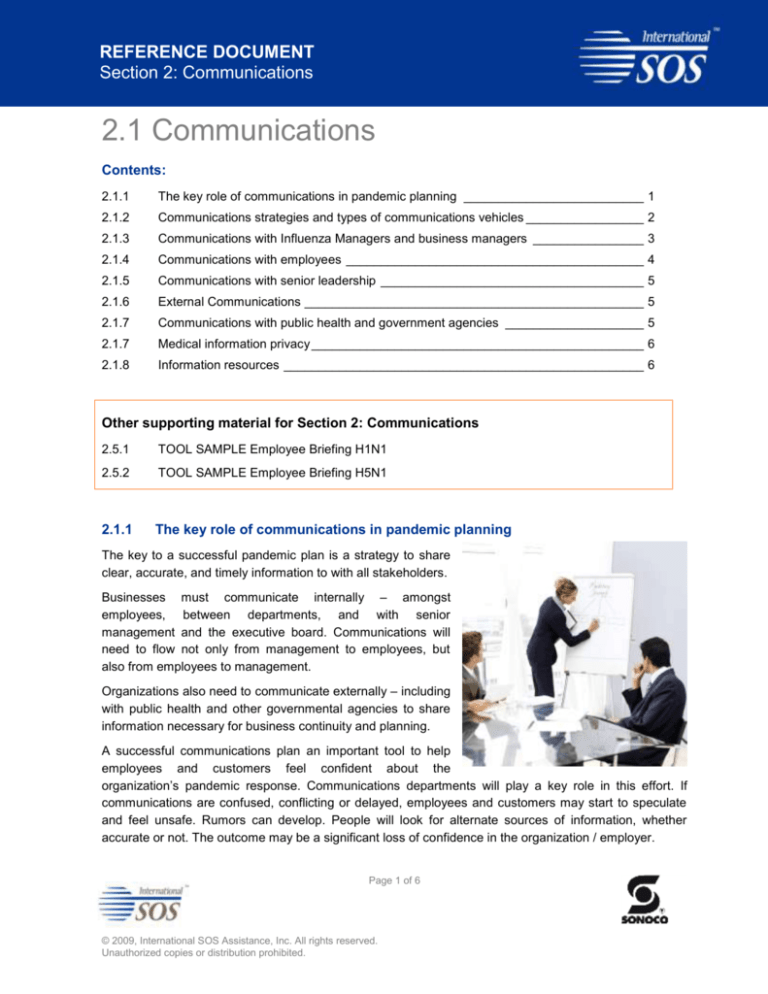
REFERENCE DOCUMENT
Section 2: Communications
2.1 Communications
Contents:
2.1.1
The key role of communications in pandemic planning __________________________ 1
2.1.2
Communications strategies and types of communications vehicles _________________ 2
2.1.3
Communications with Influenza Managers and business managers ________________ 3
2.1.4
Communications with employees ___________________________________________ 4
2.1.5
Communications with senior leadership ______________________________________ 5
2.1.6
External Communications _________________________________________________ 5
2.1.7
Communications with public health and government agencies ____________________ 5
2.1.7
Medical information privacy ________________________________________________ 6
2.1.8
Information resources ____________________________________________________ 6
Other supporting material for Section 2: Communications
2.5.1
TOOL SAMPLE Employee Briefing H1N1
2.5.2
TOOL SAMPLE Employee Briefing H5N1
2.1.1
The key role of communications in pandemic planning
The key to a successful pandemic plan is a strategy to share
clear, accurate, and timely information to with all stakeholders.
Businesses must communicate internally – amongst
employees, between departments, and with senior
management and the executive board. Communications will
need to flow not only from management to employees, but
also from employees to management.
Organizations also need to communicate externally – including
with public health and other governmental agencies to share
information necessary for business continuity and planning.
A successful communications plan an important tool to help
employees and customers feel confident about the
organization’s pandemic response. Communications departments will play a key role in this effort. If
communications are confused, conflicting or delayed, employees and customers may start to speculate
and feel unsafe. Rumors can develop. People will look for alternate sources of information, whether
accurate or not. The outcome may be a significant loss of confidence in the organization / employer.
Page 1 of 6
© 2009, International SOS Assistance, Inc. All rights reserved.
Unauthorized copies or distribution prohibited.
2.1 REFERENCE DOCUMENT: Communications
Version 6, June 2009
The messages developed for various audiences in a pandemic must be consistent with the style and
format used in communications created for other business continuity issues. Responses to external
groups, including customers and suppliers, may require preparation by the company’s communications
professionals.
This section provides information useful to the Pandemic Planning Team, especially those in the
Communications Department. The Pandemic Plan Action Table outlines the triggers for escalating
communications.
2.1.2
Communications strategies and types of
communications vehicles
Messages concerning pandemic influenza must be concise, accurate,
and timely. Some communications will contain medical information about
pandemic virus, which must be aligned with that provided by public
health agencies such as the US Centers for Disease Control and
Prevention (CDC) and the World Health Organization (WHO).
Employers need to be able to contact every employee immediately in an
emergency. Likewise, employees must be able to communicate rapidly
with their employer. Companies must have a system in place that can
record and track communication with each employee.
Organizations must also have a plan for communicating with vendors,
suppliers, and clients.
For these reasons, contingency communication plans should be drawn up during the interpandemic /
early pandemic alert period. These will detail the solutions that can be progressively implemented as the
pandemic progresses.
Communications should contain at least the following:
The background to the situation
The impact / potential impact on the company
What the company is doing to mitigate the impact and protect its employees
Sources of trusted information (such as Influenza Managers, supervisors, employees,
International SOS, and local and national public health agencies)
Reassuring employees that the Pandemic Planning Team has prepared for a pandemic and is
following an established Pandemic Plan in responding to a changing situation
What actions employees can / should take
Page 2 of 6
© 2009, International SOS Assistance, Inc. All rights reserved.
Unauthorized copies or distribution prohibited.
2.1 REFERENCE DOCUMENT: Communications
Version 6, June 2009
Each company, and location within the company, will have unique communications vehicles. These can
include:
Web-based company portal with pages accessible to employees with system IDs
Internal email system capable of distributing messages to individuals and specific groups
Web-based alerts for specific departments, such as Health & Safety, Human Resources
Capability to link portal pages to external web sites
Distribution points for printed messages (posters, announcements) for employees without access
to company intranet site. Examples are bulletin boards, morning production meetings, distribution
of flyers at point of entry (facility entrance).
Each identified communication channel should have a designated back-up channel in case the primary
system becomes overloaded or breaks down.
All contact details (names, phone numbers, e-mail addresses, etc.) must be up-to-date and regularly
checked for accuracy. Employees should be aware of the importance of updating their files whenever a
change occurs.
The communications systems should be regularly tested. As the pandemic phase escalates, testing
should be done more frequently.
2.1.3
Communications with Influenza Managers and
business managers
Many sources of information will be available concerning a flu
pandemic, some of which will presenting confusing, conflicting
and inaccurate information. Pandemic information needs to be
reviewed by the Pandemic Planning Team so that managers can
understand its impact on company operations. At times, the
assistance of the medical advisor may be required to interpret
information, helping managers decide whether “action triggers”
have been reached.
Influenza Managers play a key role in managing the impact of
pandemic influenza virus on the workplace. Once an Influenza
Manager is appointed by the senior facility manager or Human Resources representative, all employees
at the site should be given the Influenza Manager’s contact information.
The Influenza Manager must have access to appropriate communications vehicles and networks to
quickly relay needed information to the Pandemic Planning Team. Influenza Managers must be oriented
to the Pandemic Influenza Virus communications plan as part of their training to meet their
responsibilities. They must also have basic public speaking skills suitable for addressing groups at their
facility, and the judgment needed to appropriately refer questions and external requests to the Pandemic
Planning Team.
Page 3 of 6
© 2009, International SOS Assistance, Inc. All rights reserved.
Unauthorized copies or distribution prohibited.
2.1 REFERENCE DOCUMENT: Communications
Version 6, June 2009
Supervisors and business managers must receive an orientation from the Pandemic Planning Team to
familiarize them with the company’s Pandemic Plan and its pandemic preparedness communications. A
multidisciplinary approach to this training will aid them in understanding the company’s policies and their
rationale, as well as the resources available for the managing the impact of the pandemic. They must
receive training on the appropriate handing of internal and external inquiries at their facility.
Business managers may also have volunteered to assist health agencies or facilities in their communities
in a variety of positions. Some may serve on Boards of Directors of these groups, while others may
provide time as service volunteers. Their interaction as a volunteer may provide insight into the Pandemic
Planning process for these health agencies or facilities. A business manager serving on the Board of
Directors of a local healthcare facility may develop a unique insight into Pandemic Planning.
2.1.4
Communications with employees
Educating employees is a vital part of pandemic preparedness.
Understanding how important it is to prepare for a pandemic, the
nature of the virus, and what responses are appropriate may not
only prevent infection, but also contain panic and unnecessary
anxiety.
All employees, regardless of job duties or location, must receive
pandemic preparedness communications. This includes both
facility-based employees, whether in administrative or production
jobs, and field-based employees who may be traveling from a
home office.
Media attention to influenza and other infectious disease
outbreaks have made employees aware of some of the health issues and concerns that might be
anticipated during an influenza pandemic. They may have had an adverse health event during a prior
seasonal influenza outbreak, during the SARS outbreak, or during the recent novel Influenza A(H1N1)
virus global pandemic.
It may be reassuring for employees to hear about the company’s Pandemic Planning Team effort to
minimize the risk of becoming infected with the virus at work. Doubt, mistrust, panic and high rates of
absenteeism might be prevented by timely, credible pandemic preparedness communications.
Communications vehicles listed in Section 2.1.2 will all probably be necessary for employee
communications efforts. Regardless of the vehicle used, communications should be easily accessed and
translated into different languages as necessary to communicate with various employee groups.
Page 4 of 6
© 2009, International SOS Assistance, Inc. All rights reserved.
Unauthorized copies or distribution prohibited.
2.1 REFERENCE DOCUMENT: Communications
Version 6, June 2009
2.1.5
Communications with senior leadership
Senior company leaders may have additional needs for
pandemic preparedness communications. Their interest
in, and support of, pandemic preparedness during
business group discussions and site visits will
emphasize the its importance within the company’s
culture. Interactions with peers at other companies,
including customers and suppliers, may be facilitated by
a basic familiarity with the company’s Pandemic
Preparedness Plans.
Senior leaders are also more likely to travel
internationally on company business. The frequency of international business travel may increase their
risk of infection with the pandemic influenza virus. Communications concerning emergency medical
assistance while travelling internationally will be especially important for them.
2.1.6
External Communications
Many external groups now expect companies to have a Pandemic Preparedness Plan in place.
Customers, suppliers, and other business groups may ask for information of varying complexity about
your organization’s pandemic preparedness. Community groups, including public health agencies and
healthcare providers, may seek information about the inclusion of pharmacologic and non-pharmacologic
interventions in the company’s plan. Local and national media may inquire about the pandemic
preparedness for a particular facility, business, or the entire corporation.
The company will need a designated spokesperson or department to manage external communication
about its pandemic preparedness. All inquires need to be forwarded to this designated resource to ensure
responses are factual, consistent, and inspire confidence in the pandemic planning process.
Messages for external communications need to be developed in advance. Such messages require
periodic updating as the company Pandemic Preparedness Plan changes. The designated spokesman or
department must assume this responsibility and work with the Pandemic Planning Team be sure that all
internal and external communications are consistent.
2.1.7
Communications with public health and government agencies
Information from public health agencies, such as the US Centers for Disease Control and Prevention
(CDC) and the World Health Organization (WHO), is an important resource for company Pandemic Plans.
“Action triggers” used in Pandemic Action Tables can depend heavily on an assessment by local health
agencies of the number of pandemic influenza cases and the “severity” of the virus. It is important that the
Influenza Manager maintain communication channels with local public health agencies. Such channels
may involve information posted on local and regional web-based pandemic resources.
Page 5 of 6
© 2009, International SOS Assistance, Inc. All rights reserved.
Unauthorized copies or distribution prohibited.
2.1 REFERENCE DOCUMENT: Communications
Version 6, June 2009
Local public health agencies may ask Influenza Managers for information concerning the company’s
pandemic plan. Such requests should be handled through the company’s designated spokesperson or
department.
The Corporate Pandemic Planning Team should also be aware of the role of national public health
agencies as well as the location of timely updates.
2.1.7
Medical information privacy
Many countries have regulations surrounding medical
information and privacy, designed to safeguard their citizens’
confidential medical information. In most circumstances,
summary aggregate information concerning the impact of an
influenza pandemic, including the number of cases at a facility,
would not be considered confidential. However, any personal
information that could be used to identify an unnamed employee
should not be disclosed. (US Social Security number, employee
ID number, date of birth, etc.)
If public health agencies require that contact tracing information be provided during a public health
emergency, it is prudent for the Influenza Manager or other company representative to notify the
employee that such information will be reported to the agency.
Employees will certainly discuss the situation – including infections
among staff – with each other. They need to be directed to respect
their co-workers’ privacy. Although employees talk freely about their
health histories with co-workers in many countries, it is not
appropriate to disclose personal identifiers concerning a suspect,
probable, or confirmed case. Co-workers may make unwarranted
assumptions based on rumors when there is inconclusive evidence
available.
2.1.8
Information resources
Below is a list of web-based resources:
International SOS Pandemic Preparedness Website
www.internationalsos.com/pandemicpreparedness/
World Health Organization (WHO)
www.who.int/en
U.S. Centers for Disease Control and Prevention
www.cdc.gov
Local teams should also refer to their state / local public health department information.
Page 6 of 6
© 2009, International SOS Assistance, Inc. All rights reserved.
Unauthorized copies or distribution prohibited.

